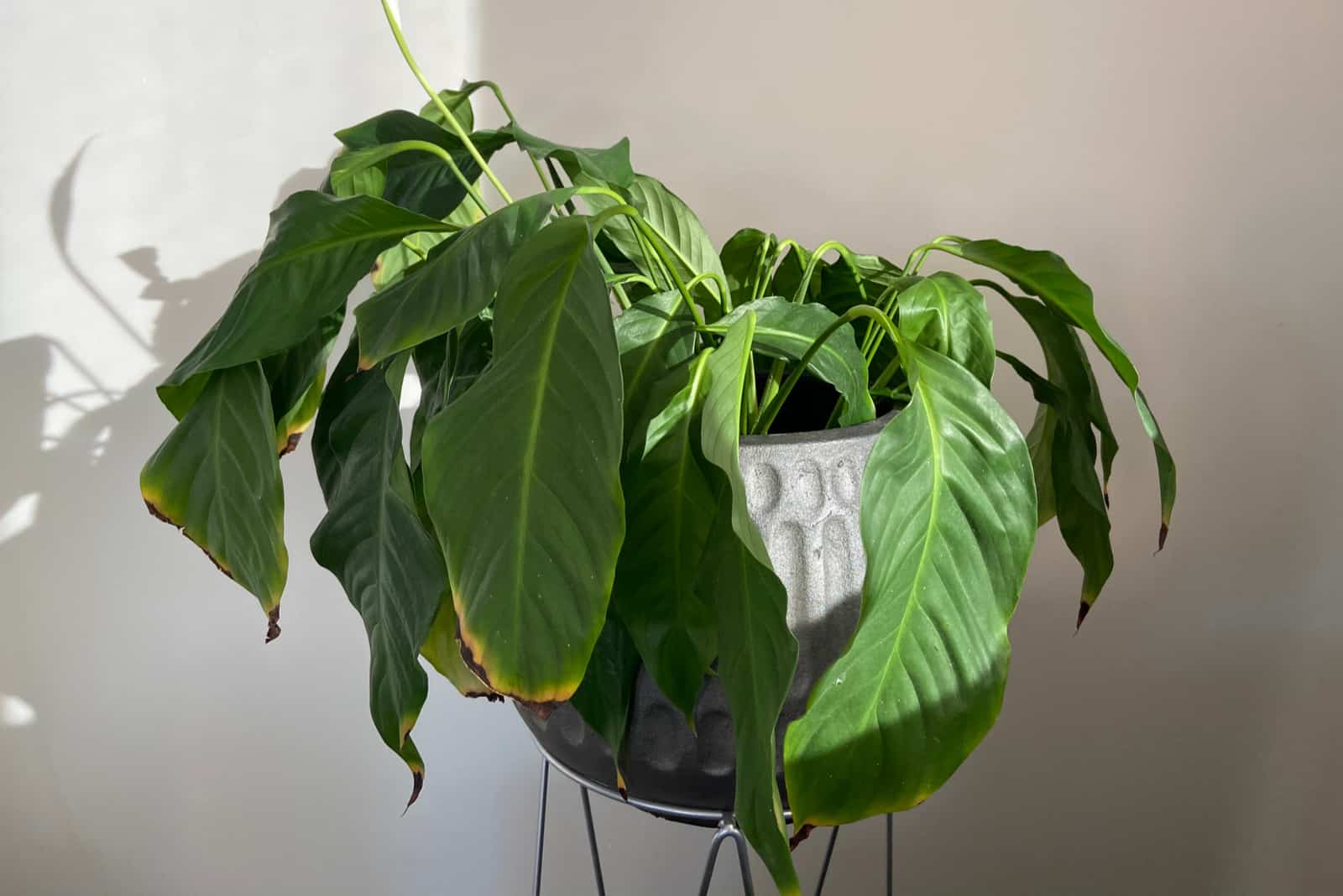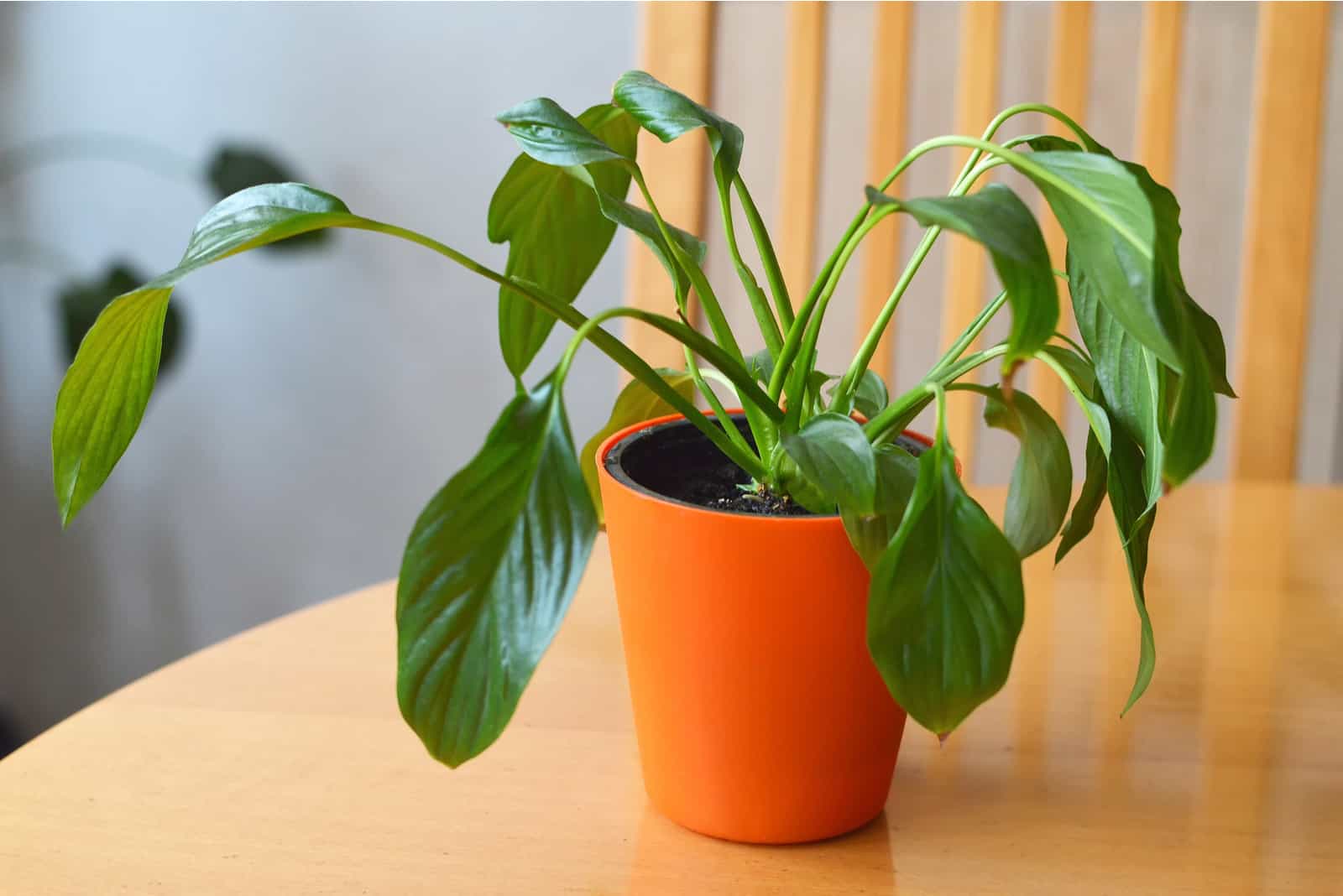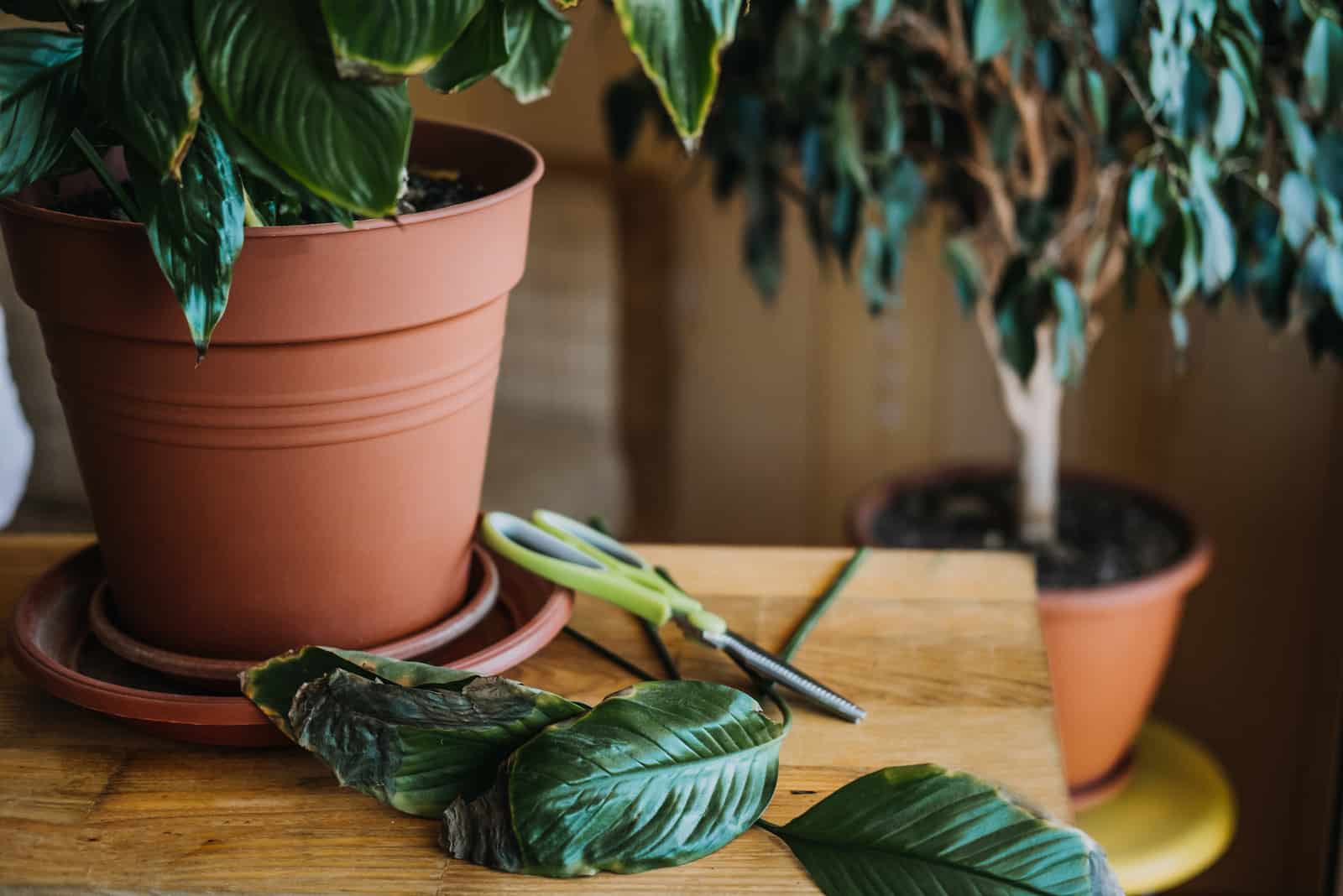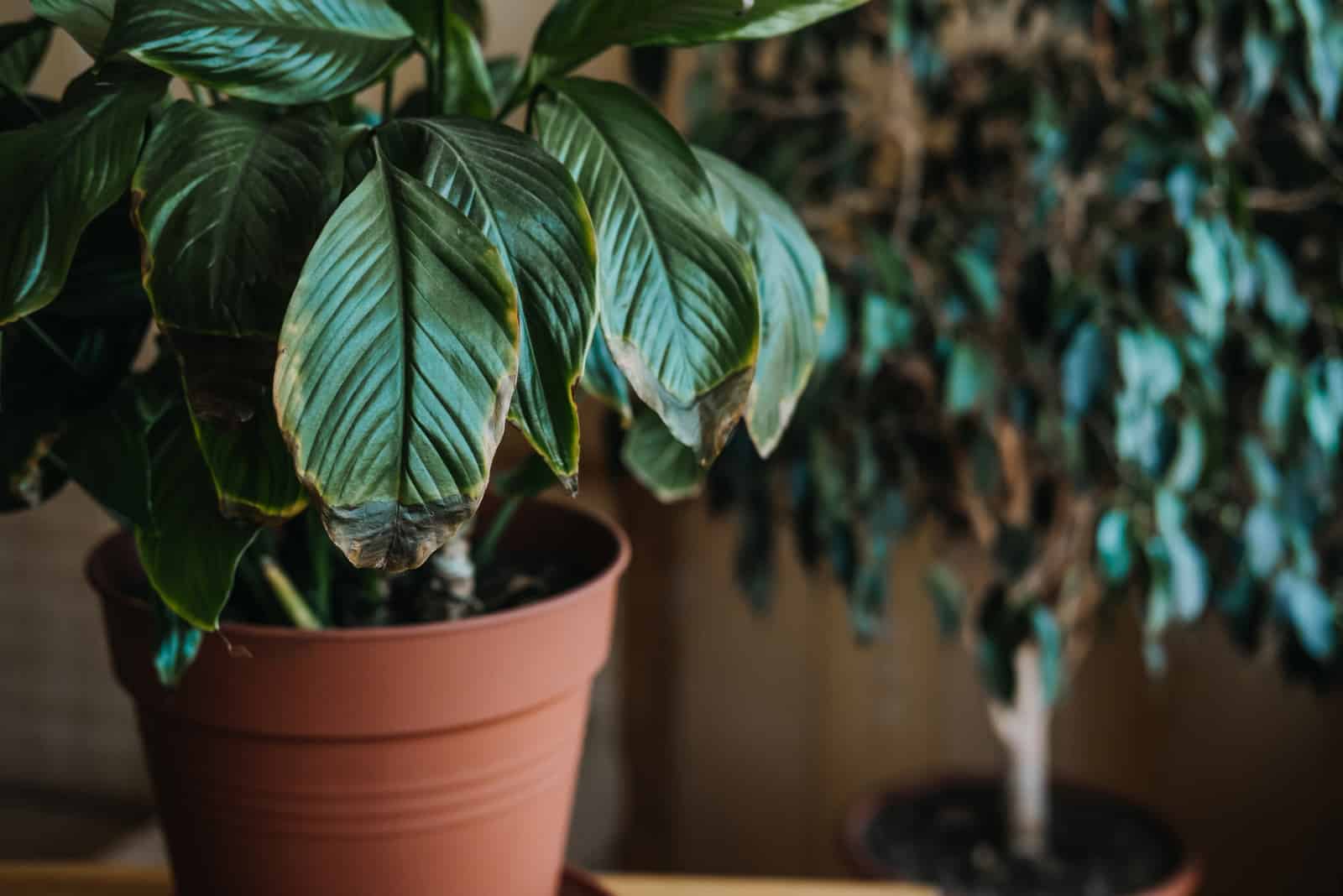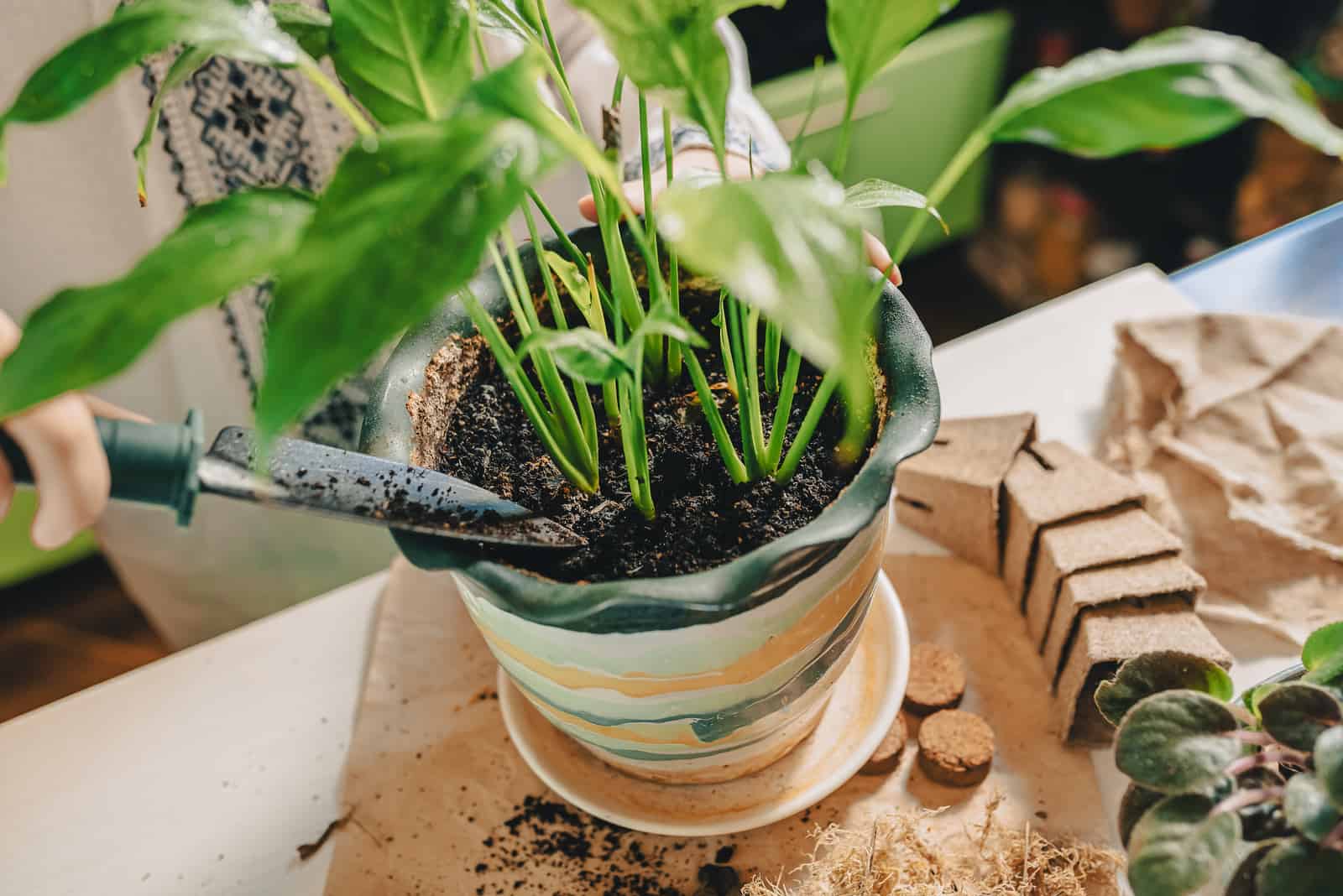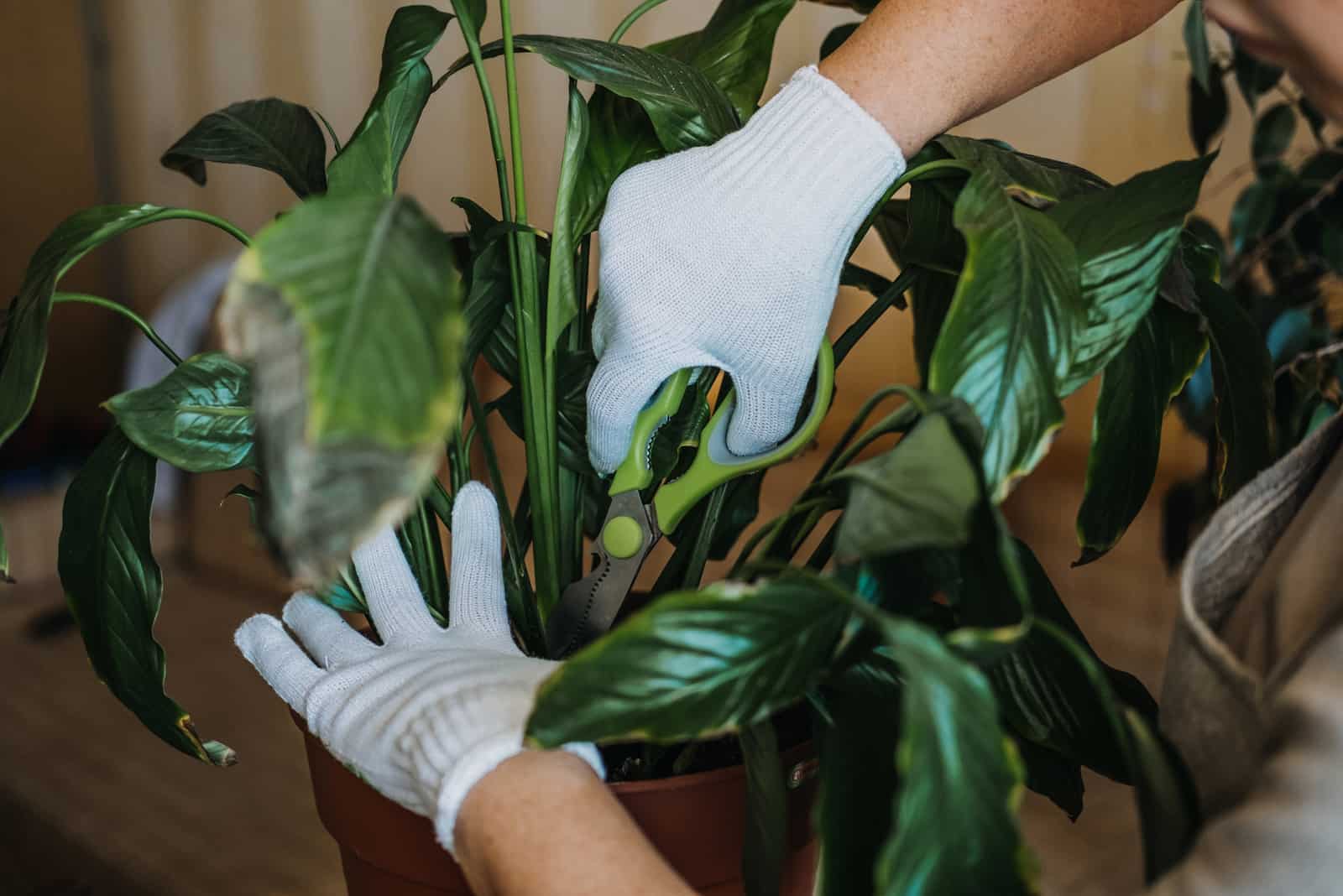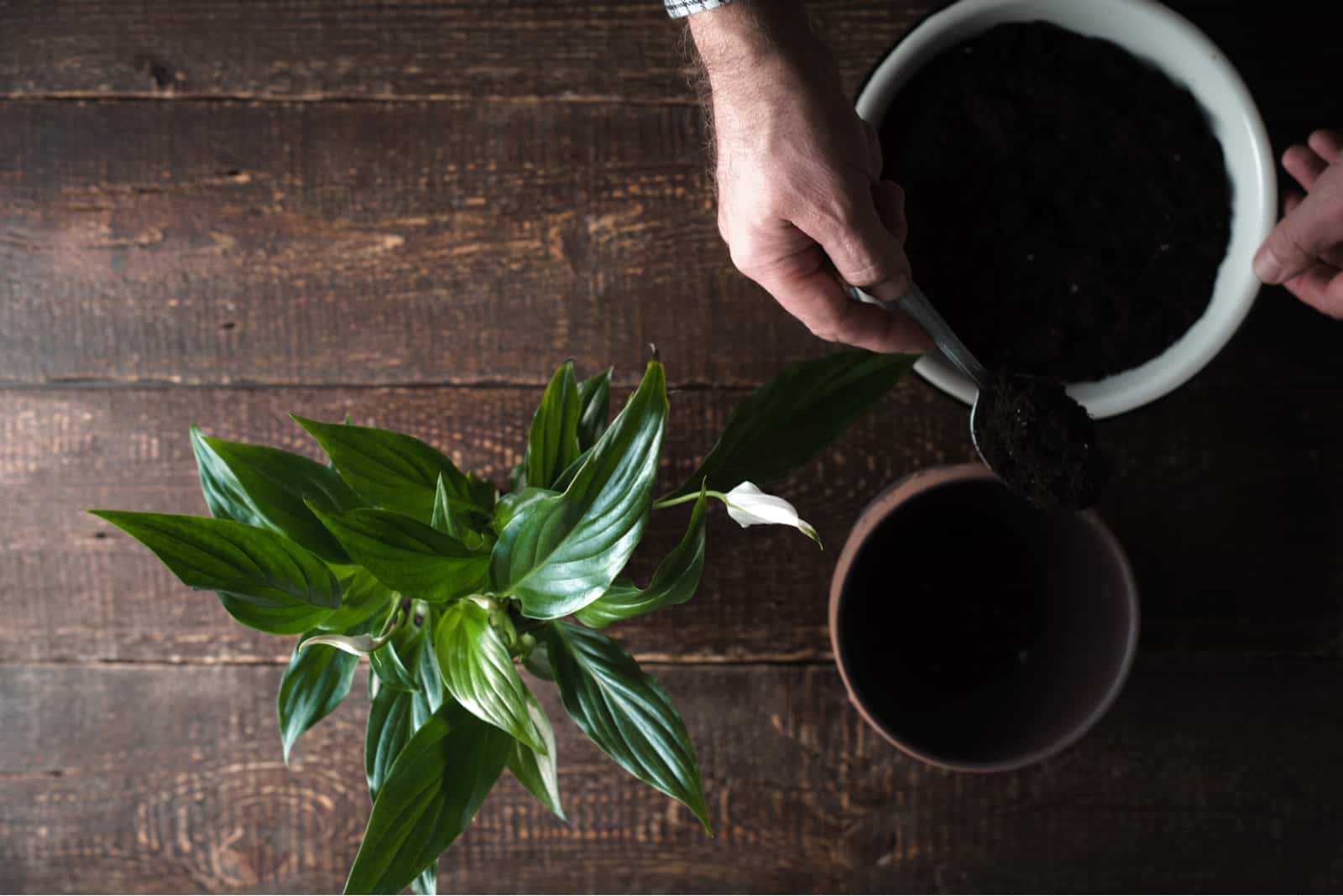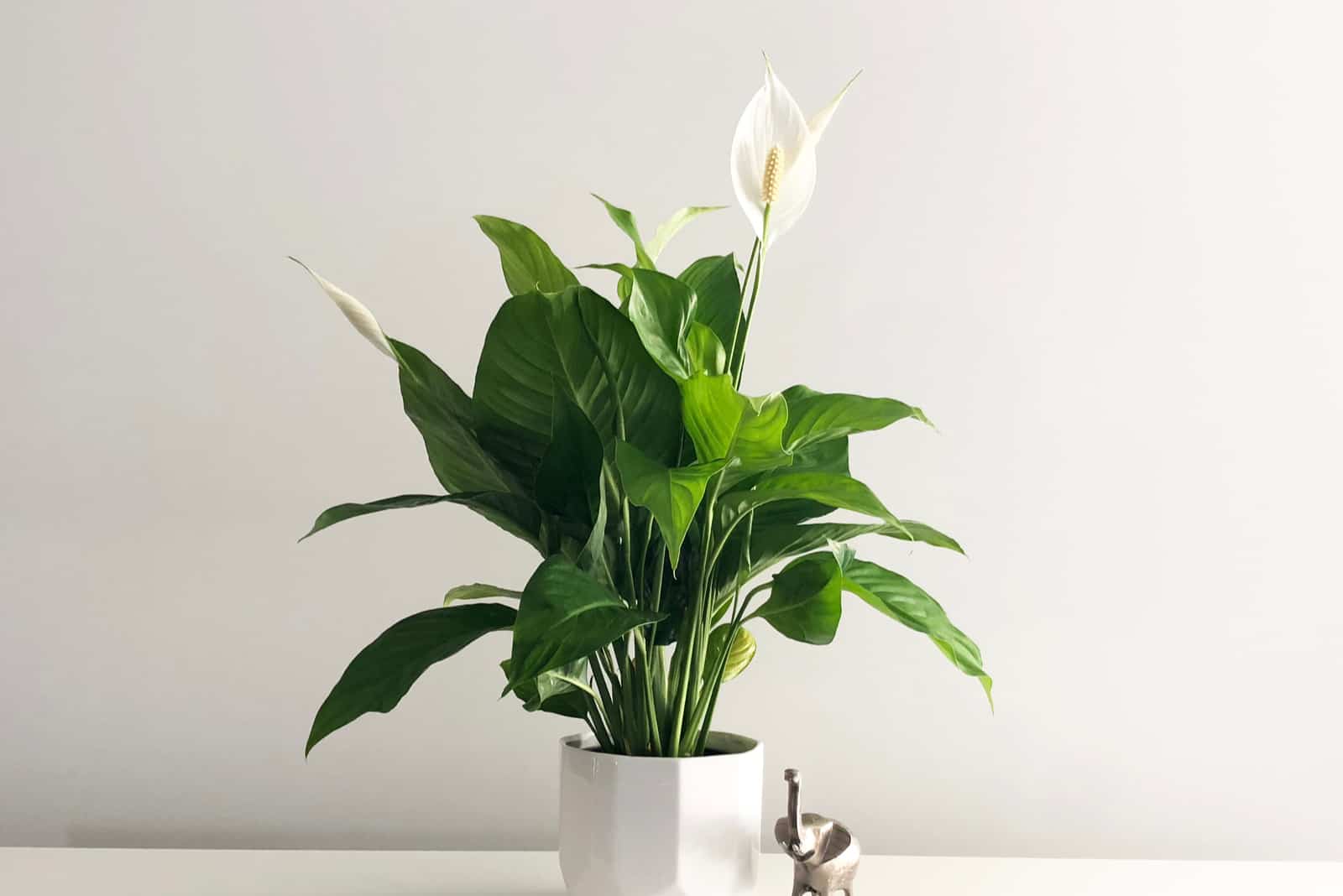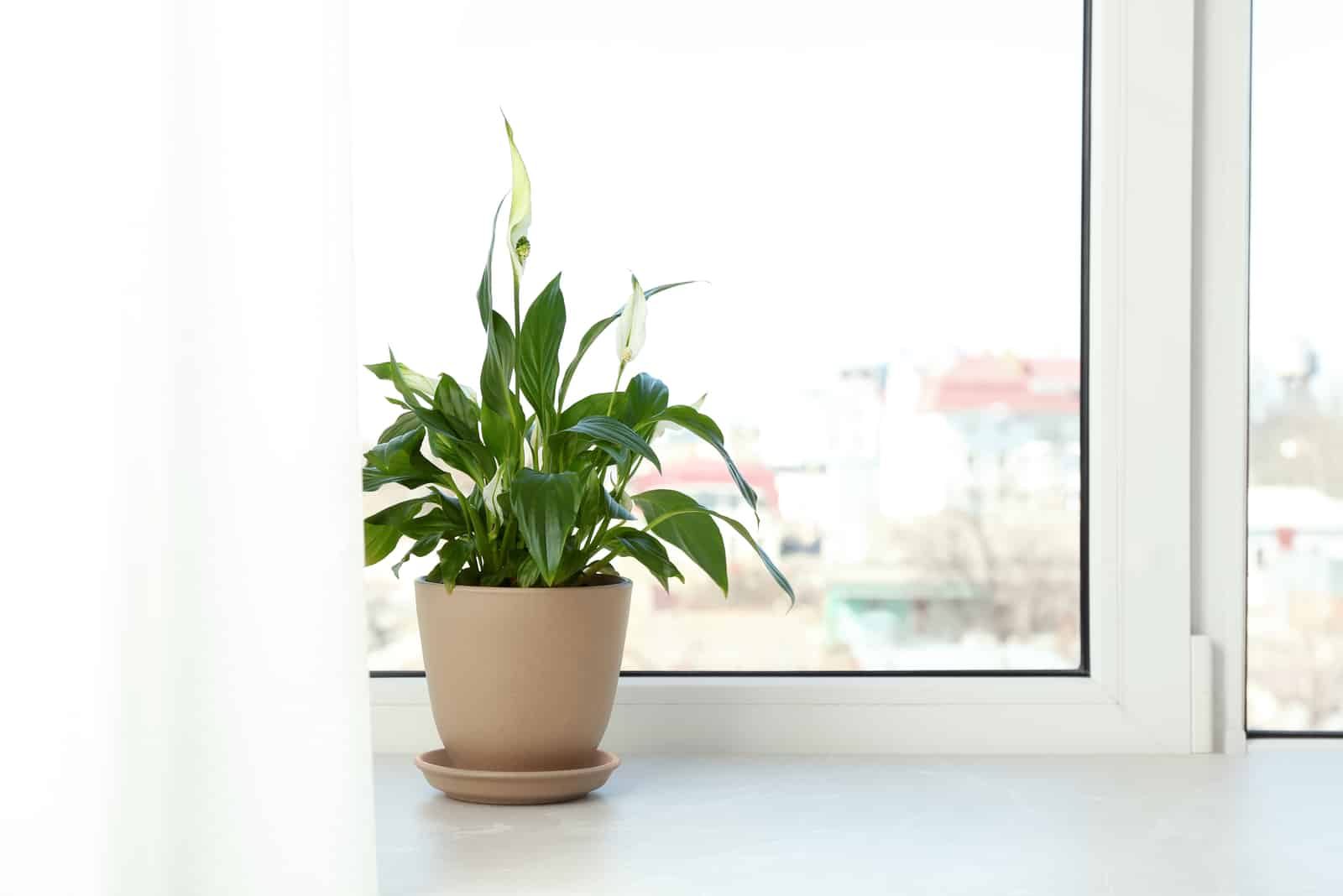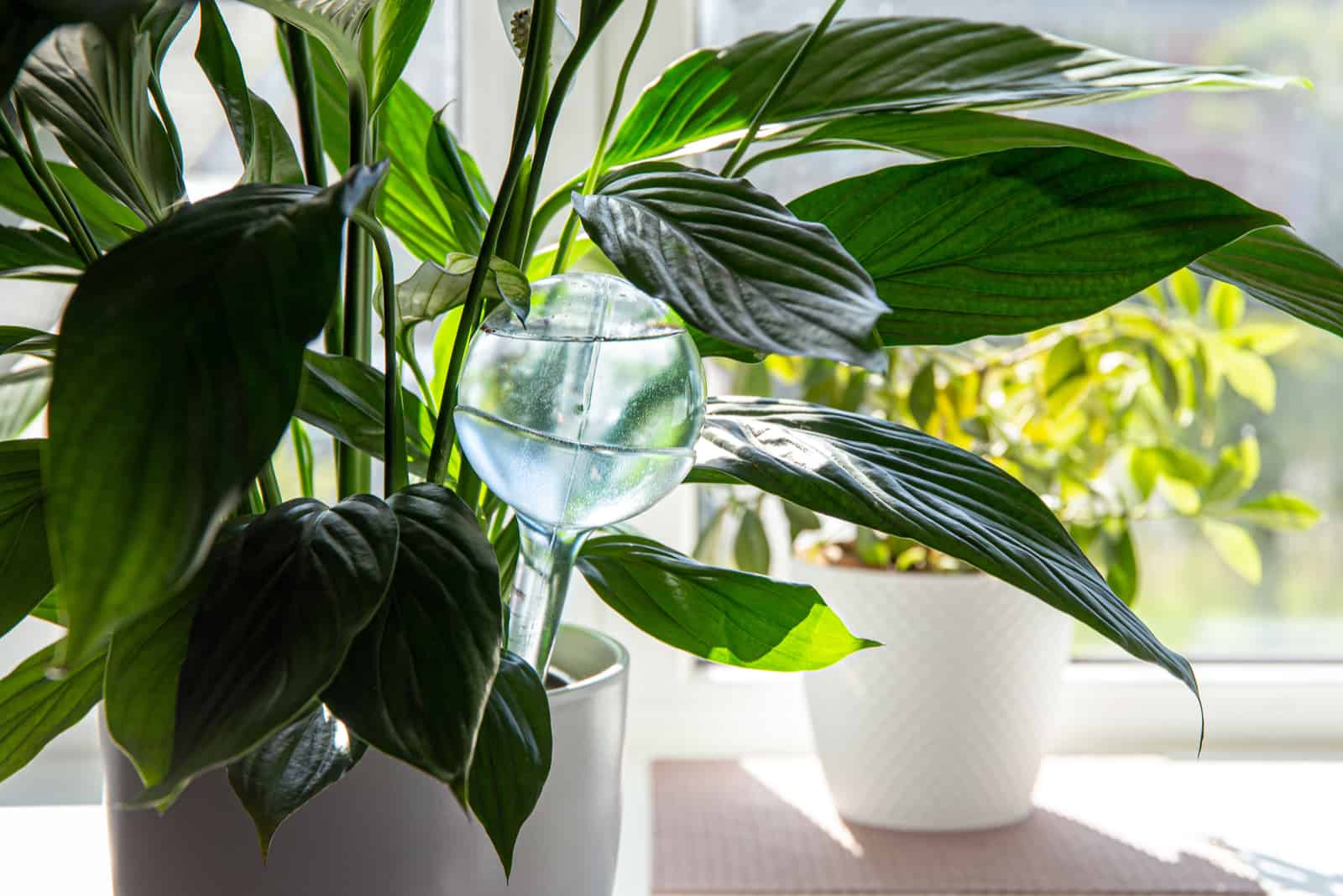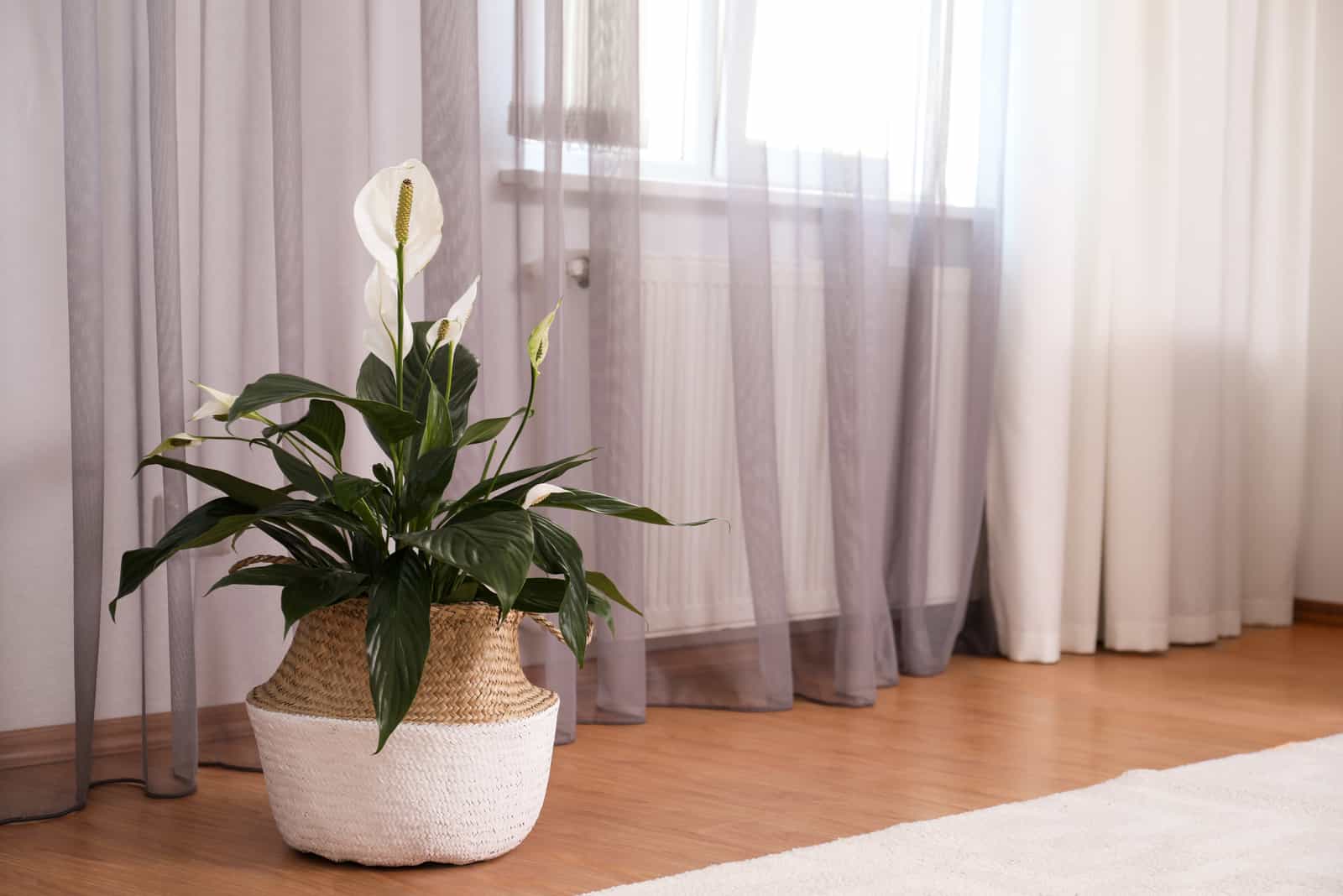I know how disheartening it can be to see your peace lily drooping. Unfortunately, it happens a lot.
As the peace lily is a very common houseplant and many plant growers have this problem (including me), there is now a solution.
Why is my peace lily drooping? There may be many reasons, and they are usually related to inadequate watering, high temperature, low humidity, root issues, and soil issues.
When you notice your peace lily leaves drooping, act immediately as this can lead to permanent damage.
Let’s find the answer to your peace lily drooping and understand why this happens.
Why Is My Peace Lily Drooping? Causes
The Peace lily, scientifically known as Spathiphyllum, has upright, beautiful green leaves. When they start to droop, you should inspect the plant further.
Discoloration of the peace lily leaves, changes in the root system, and changes in the soil (appearance and smell) are likely to follow drooping.
Let’s dig deeper!
Underwatering
A Peace lily needs to be watered more often when compared to other houseplants. If you forget to water it just once or don’t follow the watering schedule properly, you will notice that the leaves start drooping.
Why does underwatering cause drooping? The peace lily plant needs to receive enough water to build cells that participate in photosynthesis.
If the leaves don’t receive enough water, they become unable to sustain the structure. As a consequence, they droop. I have to mention that this is the first sign of underwatering and may be solved at these early stages.
However, if underwatering continues, other changes might occur, such as the leaves turning yellow or dry patches developing on the surface.
Luckily, dry tissue won’t spread any disease, but it’s essential to act as soon as possible to solve the problem.
Overwatering
Overwatering is the main cause of most plants’ issues. Overwatering causes the cells and tissues to lose their structure and very often burst. Consequently, the leaves soften and eventually droop.
Unfortunately, some tissue, or even the entire leaves, won’t recover.
What Does An Overwatered Peace Lily Look Like?
Apart from general drooping, some other changes in the plant’s appearance might occur.
The first sign of an overwatered peace lily is the discoloration of its leaves. The leaves turn yellow and have brown leaf tips, and spots of many different colors may appear.
Mushy topsoil with an unpleasant smell is also a sign of overwatering.
If you inspect the roots within the soil, they will be mushy, rot, and discolored if the plant is overwatered.
Peace Lily Leaves Drooping Due To Root Rot
Root rot is a disease caused by waterlogged soil, caused by overwatering and high humidity. It destroys the tissue the plants are made of, leading to the debilitation of the plant.
Untreated root rot can cause severe damage to the other parts of the plant. First, the leaves will droop and, as the problem progresses, the central part of the plant where the leaves come from (the crown) may be affected.
Apart from drooping, the leaves will turn yellow and be soft to the touch (softening of the tissue). Eventually, the yellow will turn to brown or black, and affect the crown. Therefore, the entire plant will be affected.
Waterlogged soil and high humidity will allow a fungus, Cylindrocladium (from the Nectriaceae family), to enter the openings or wounds of the plant’s body.
To inspect the roots and determine if they suffer from rot, you should take the plant out of the pot. If the roots aren’t firm and white but somewhat mushy and brown, they most likely suffer from root rot.
Low Humidity
This plant is native to South America’s rainforests. As the humidity is higher in these areas, the best method is to imitate it.
The peace lily requires high humidity levels (over 60%). However, if the humidity drops below 40%, the plant will perspire too much, and eventually, the leaves will droop.
Other issues may occur with drooping leaves, such as yellow, crispy, and dry leaves. If untreated, the leaves will turn brown, especially the edges (edge burn).
Direct Sunlight
If the peace lily plant is exposed to direct sunlight for a more extended period, it will dehydrate. The stomata (pores) perspire too much water in this case.
The number of pores affected determines how much light, humidity, or heat the pores transpire.
The Spathiphyllum species have numerous pores, which means they perspire a lot.
Excessive transpiration occurs if the plant receives too much sunlight, leading to the drooping of leaves.
In excessive transpiration, the leaves also turn yellow, and the tips become dry.
Inadequate Temperature
Many houseplants won’t show any changes if the temperature goes down or up.
However, the peace lily is known for its very delicate leaves. Any temperature change will cause a peace lily’s leaves to droop, and drooping leaves are the first sign of temperature changes.
To understand why a change in temperature causes drooping, we should look at the plant’s physiognomy, shape, and the structure of its leaves.
The peace lily’s stalk is long, thin, and leafy (the most common houseplants have woody stalks). Interestingly, it is not considered an actual stalk but rather a petiole. The petiole carries thin and large leaves, so it doesn’t have much strength.
Due to this feature, the plant immediately responds to sudden changes in temperature. Therefore, if the temperature goes up or suddenly drops, it can cause the leaves to droop.
The best temperature for a peace lily ranges from 65 to 85 °F. This plant may live in temperatures ranging from 40 to 100 °F, but it will most likely start to suffer, and leaf drooping will be the first sign of this. I suggest you don’t test if it can live in higher or lower temperatures than those mentioned above.
Wrong Potting Soil
As you may know, plants uptake the nutrients from their soil, which is why an appropriate potting mix is essential. If it’s inadequate, the plant won’t receive enough nutrients (nutrient deficiency).
On the other hand, the wrong potting mix can also provide the plant with too many nutrients, leading to toxicity.
However, strong nutrient deficiency or toxicity may not be the reason for a plant’s suffering; a peace lily simply may not have the nourishment it needs.
The first parts to suffer from the wrong potting mix are the leaves, which will start drooping. You will also notice yellow leaves and brown spots on the leaves.
When it comes to the soil, three things can affect it:
• It doesn’t retain water (moisture decreases).
• It has poor drainage (the soil becomes waterlogged).
• Poor aeration (the roots can’t breathe, uptake the nutrients, or receive water).
The Peace lily plant can’t withstand two types of soil:
• Soil with higher concentrations of sand; over 30%. Loam or peat-based soil should have a bit of sand. If it goes over 30%, the plant may suffer.
• Clay soil is too compact, has poor aeration, and doesn’t retain water.
The Signs Of An Inadequate Potting Mix
To determine that your peace lily is drooping due to poor soil, check for these signs:
• Pools of water on the topsoil or under; the soil has too much clay. There aren’t enough air spaces in the soil due to poor water retention (excess water doesn’t drain).
• The soil dries up fast when you water it (I mean really fast). It has higher concentrations of sand than recommended.
Pest Infestation
So tiny and yet so dangerous!
These annoying creatures are the unwanted guests of all indoor plants. Who could imagine that such a tiny creature would cause droopy leaves? Let’s see the culprits.
Mealybugs are the most likely pests that affect the peace lily plant. They suck in the sap of a peace lily, and it loses its strength. Consequently, the leaves droop.
The xylem (part of the plant which carries the sap) is an essential part of the leaf.
Don’t worry if you spot a few mealybugs on the leaves. You can quickly get rid of the mealybugs, and the plant can handle a few mealybugs.
The problem is their fast spreading. If there’s nothing to fight these pests, they will spread and cause more and more damage.
Many confuse so-called plant dandruff with mealybug pests. They look like cotton buds and can appear anywhere on the plant.
If they keep sucking in the sap, the plant will lose its energy and show its first symptoms.
The very name of the plant suggests that it only wants peace and that the annoying mealybugs are the only ones who want to fight. They are most likely to win the battle too if you don’t prevent them.
Peace Lily Drooping Due To Transplant Shock
A Peace lily needs repotting if it suffers from root rot, pest infestation, or other severe conditions.
However, Spathiphyllum plants also need to be repotted after you purchase them and when they outgrow their pot. The plant can experience transplant shock.
Other common causes of transplant shock are temperature and air fluctuations in the room where you have moved the plant to.
A droopy peace lily, in this case, needs time to adapt.
How To Revive A Drooping And Wilting Peace Lily
There are many common reasons for a drooping peace lily. Fortunately, in most cases, you’ll be able to revive the plant and ‘bring back’ its glorious appearance.
To revive a drooping and wilting peace lily, you will have to change its watering habits if you determine that watering issues caused the plant to droop.
In the case of root rot or pest infestation, it would be best to remove them. You may also consider increasing the humidity, moving, or repotting the plant.
Let’s see how to revive drooping and wilting plants depending on the cause.
Solution To Watering Issues
First, let’s discuss how to deal with overwatering issues. Put your finger in the soil; wet soil means that you have overwatered the plant.
Never expose the plant to the sun to dry; this is the worst thing you can do as it can suffer from shock and could die.
The key is to postpone watering for some time. Half of the topsoil should be dry befoe you water the plant again. The plant isn’t drought-tolerant, so don’t wait until the entire soil dries up.
Some leaves may never recover. In this case, using a sharp and sterilized blade, remove the leaves (they may have started to rot).
Solution To An Underwatered Peace Lily
On the other hand, if you conclude that lack of water caused the drooping, the plant needs watering.
To check if the soil lacks water, take a wooden stick and put it in the soil. If it comes out with no soil attached, it’s time to water your peace lily plant.
Use room temperature water and water the plant. I have to remind you that you shouldn’t soak the entire plant to revive it. Avoid using sinks or bathtubs as you don’t want to overwater your plant and cause more damage.
Watering Schedule
A peace lily should be watered once a week. The previous sentence should have “IF” before the full stop, and I didn’t put it as I think it’s good to know which watering schedule to follow in general.
This may not be good news for you, but a peace lily should be watered once a week only if every requirement is fulfilled (don’t set a reminder to water the plant each Friday).
Make sure to water the plant more often if:
• The temperatures are too high (especially during summer).
• The humidity is too high.
On the other hand, water the plant less if:
• The humidity is low.
• The temperatures are lower (winter).
• The light level is lower.
All conditions above aren’t related to the extremes; for example, low light refers to slightly lower than usual.
You can choose which time of the day to water the plant, and I do it in the morning (habit, I guess). You can use tap water to water this plant, but you should leave it overnight to sit at room temperature first.
Root Rot Removal
Root rot has to be removed if you want to revive the plant. Unfortunately, a product that eliminates root rot doesn’t exist (don’t ask me how I know).
It may seem complicated to remove root rot, but it is worth every minute you spend on it.
Follow these eight steps to remove root rot.
1. Take your peace lily out of the pot.
2. Gently shake off the soil around the roots and dispose of it (it’s contaminated).
3. Using a soft brush, gently clean the plant’s roots.
4. Observe the root system and search for black, brown, or mushy roots.
5. Sterilize scissors or pruners (make sure they are sharp) and cut the affected roots.
6. If any other part of the plant is also affected by rot, cut it. Remember to sterilize the scissors or pruners after each cut. Don’t worry if you accidentally remove some healthy tissues, this won’t cause too much trouble to the plant.
7. Sprinkle some sulfur powder (organic version) on all wounds. It will kill fungus, so make sure you don’t omit any part of the plant. You can spray neem oil over the plant as an alternative to sulfur powder, it is also a fungicide.
8. Fill the pot with new soil. It’s better to use a new pot as an old pot is contaminated, however, you can clean the old pot using a fungicide.
After this procedure, your peace lily is likely to thrive again. However, if the fungus affected and destroyed the crown, you should consider getting a new peace lily.
Increase Humidity
The easiest way to increase the humidity is by using a humidifier.
The best way to keep the plant moisturized is by misting the plant with a spray bottle filled with water. Do this regularly to avoid any issues.
You can fill a saucer with water but make sure it isn’t in touch with the roots. You can add pebbles to the saucer and place the pot onto it.
Another way is to purchase a wider saucer, fill it with water, and put it under the existing one.
Keep the peace lily plant away from vents and air conditioners as they dry the air.
Kitchens and bathrooms have a higher humidity; consider moving the plant there.
Move The Plant
If you conclude that your peace lily is drooping because of the temperature, you should find a new place for it.
There shouldn’t be any heating sources near a new spot. This includes radiators, fireplaces, ovens, and windows with direct sun.
Ensure the temperature doesn’t drop below 65 °F, especially if you live in colder climates.
The peace lily plant is a tropical plant and lives under the forest canopies; that’s why the peace lily thrives best in bright, indirect light.
The best would be to use heat lamps designed for plants.
Avoid placing the plant near doors. They are often opened and closed, causing temperature fluctuations.
New Potting Soil
As mentioned, the peace lily doesn’t like clay-based or sandy soil.
The soil should have a pH that ranges from 5.8 to 6.5 (slightly acidic).
Compact soil will suffocate the roots, ensure a friable and well-aerated soil.
The soil for your peace lily should also be well-draining and rich in organic matter.
I suggest peat-based soil as it fulfills all the requirements above. It also keeps the soil moist.
Additionally, you can add some sand, perlite, or charcoal (not prone to fungus).
Repot The Plant
Always repot the plant if your peace lily is drooping because of root rot. If you notice roots coming out of the drainage holes, repot the plant.
The new pot shouldn’t be much larger than the previous one: the larger the pot, the more soil around the roots. Soil retains water and increases the susceptibility to infection, and it will eventually turn mushy and cause severe damage.
Drainage holes are essential to remove the excess water from the soil. Therefore, they create a suitable environment for the roots to grow healthily.
This will prevent waterlogging of the soil and keep the air spaces open so that the roots can breathe.
When repotting, always replace the old potting soil with fresh, as the old soil can be contaminated.
Pest Removal
How do you get rid of the annoying creatures? Before you purchase any commercial pesticides, try using the natural ones; some cheap soap should do well.
Take a bowl and fill it with water. Grate the soap and add it to water. Now do some cooking.
Place the bowl in a saucepan and heat it until the soap melts. Cool it and fill a spray bottle with it.
Don’t spare when spraying; it’s not toxic.
Peppermint essential oil can help you to keep the pests away.
I suggest mixing the soap with peppermint essential oil and spraying the plant (repels and protects).
Bye, bye mealy bugs!
What Can I Do To Make My Peace Lily grow?
Here’s a short plant care guide for your peace lily. It’s pretty easy to care for the plant, so ensure the conditions below and help your Spathiphyllum grow healthily and thrive (no more drooping, I promise).
• Water the plant when half of the topsoil is dry. Never wait for the soil to dry out completely, and you should never water wet soil. Overwatering and underwatering cause a peace lily to droop.
• Ensure the humidity is over 60%. Anything lower increases the risk of a peace lily’s leaves drooping.
• Try keeping the temperature between 65 to 85 °F. Anything lower or higher causes drooping.
• Choose a peat-based potting soil and add sand, perlite, or charcoal to improve drainage. The wrong potting mix equals your Peace lily drooping.
• Ensure a spot with bright, indirect light and avoid placing it near windows with direct sunlight.
• Repot the plant when you notice the roots are coming out of the drainage holes.
• Mist your peace lily regularly.
Wrapping Up
Why is my peace lily drooping? You’ve asked us, we answered.
There are many causes of a drooping peace lily; now that you know each one, you can use our methods to revive it.
It’s great that you’ve chosen a peace lily to be your houseplant; it’s beautiful and easy to maintain.
Take good care of it; there is nothing more pleasing than seeing it thrive.
Until next time!
Like this post? Share or pin it for later!

